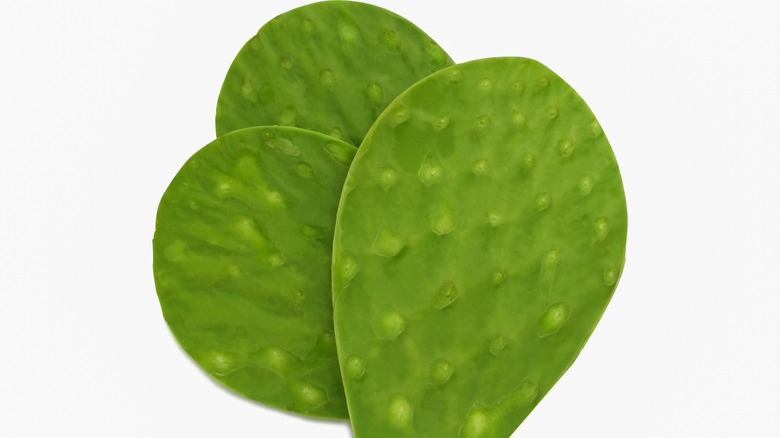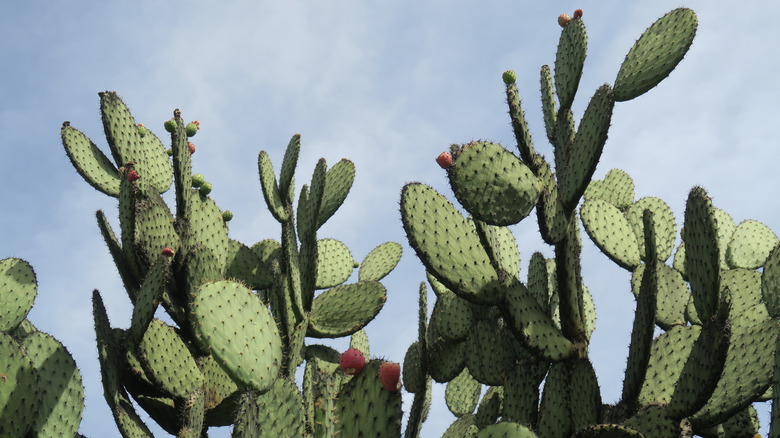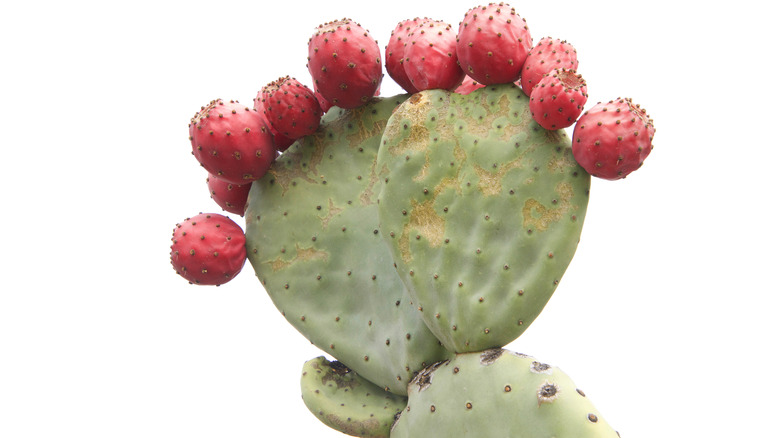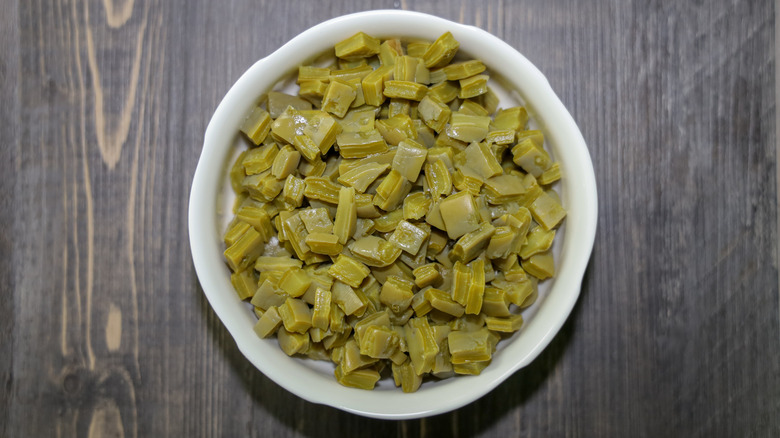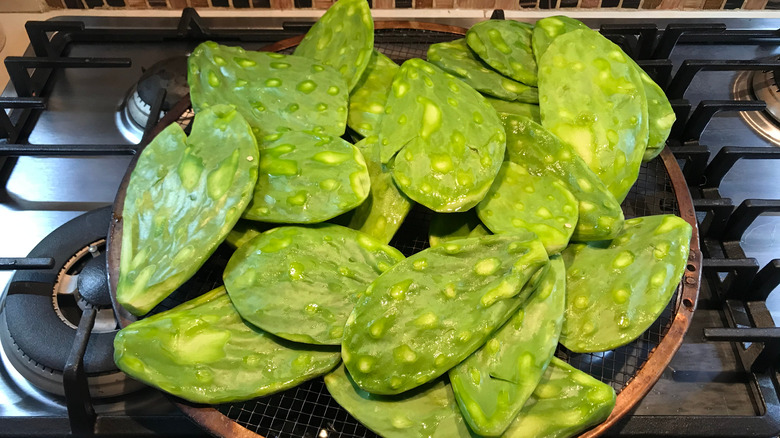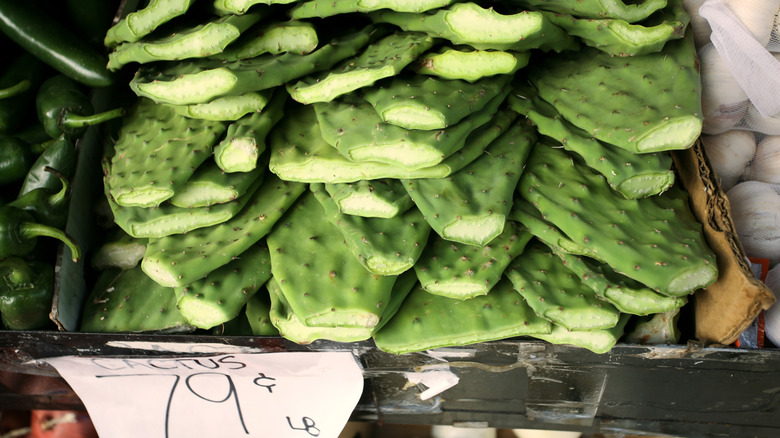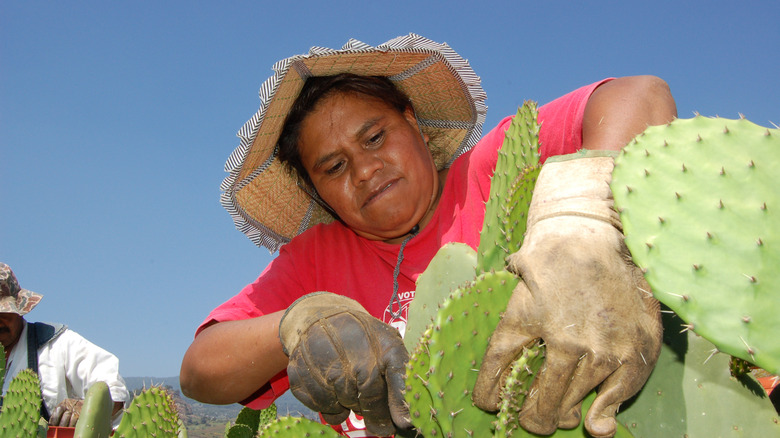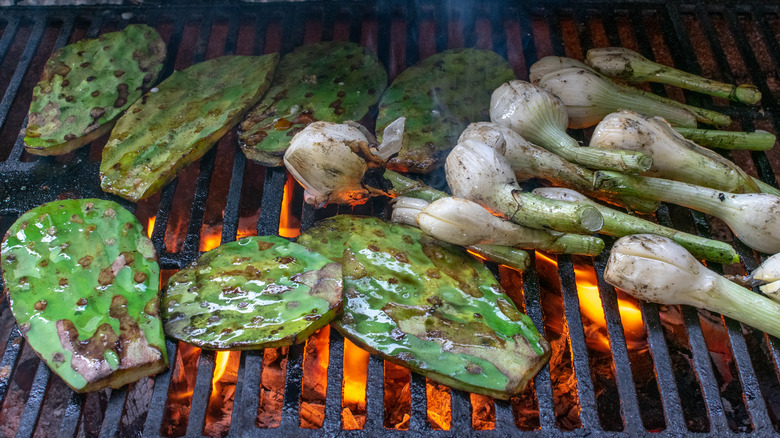What Are Nopales And How Do You Eat Them?
We may receive a commission on purchases made from links.
Perhaps you might have seen nopales on the menu at a Mexican restaurant, or one specializing in southwestern-style cuisine. You might have even seen them sold in cans or jars, where they appear as thin, flat strips somewhat similar to green chiles. So, are nopales a type of pepper then? If you have seen the fresh version, you would realize this probably isn't the case since they look more like big, flat, bumpy green paddles — perhaps something that might be used as ping-pong paddles by aliens, instead.
So, exactly what are these mystery veggies (if, in fact, they are vegetables at all)? Well, yes, nopales are a type of vegetable, according to Garden and Me, as they come from the prickly pear cactus (via FoodPrint). Although there are numerous prickly pear species, one kind that is commonly cultivated to supply nopales is Opuntia ficus-indica. If you are more into wild-harvested produce and you live in the southwest, though, you likely have an ample supply of Opuntia engelmannii possibly as close as your own backyard (via Arizona-Sonora Desert Museum). Here's everything you should know about this unusual vegetable.
What are nopales?
The term nopales is sometimes used to refer to the prickly pear cactus as a whole. All types of prickly pear belong to the genus opunta, and FoodPrint says that most prickly pear species have both edible leaves and fruits. They are not the only edible type of cacti, however. In fact, according to Kitchen Appliance HQ, the world's most cultivated cactus is the dragon fruit-bearing pitahaya. When nopales are used as a food term, it most often refers to the leaves (or paddles) of the cactus, while "prickly pear" refers to the fruit. Nopalitos, according to Gourmet Sleuth, are nopales that have already been sliced up and prepared for cooking.
As prickly pear cacti vary in shape and size, so do their paddles, but Sow Exotic says that nopales typically range from 4 to 10 inches. They are native to the Americas, and Food Literacy Center says there are more than 114 species of prickly pear in Mexico alone. In fact, in that country, more than 7 million acres are given over to cultivation of the incredible edible opunta — and the cactus even appears on their flag. There's at least one major commercial grower in California, as well, although the plants grow wild all over the Southwest and even on sandy East Coast beaches. Prickly pear cacti also grow in the Mediterranean, the Middle East, India, Africa, and Australia, although on the latter two continents, they're considered to be an invasive species.
What's the difference between nopales and prickly pear fruit?
So, if nopales and prickly pear fruit both come from the same plant, does this mean they are more or less the same thing? No, not at all. For one thing, as Garden and Me points out, an edible cactus like prickly pear is both a fruit and a vegetable — the fruit, the actual prickly pears themselves, are the seed-bearing part of the plant, while the nopales are the non seed-bearing leaves. The leaves of the cactus are harvested in early spring and summer, while the fruits ripen later in the summer and fall (via Edible Monterey Bay).
The prickly pear fruits, which FoodPrint says also go by the names of Indian figs, Barbary figs, cactus pears, and even tunas (no relation to the fish, obviously), are much, much sweeter than nopales. Simply Recipes compares their flavor to watermelon and bubblegum, so it comes as no surprise that they are often used to make candies and jams, and to flavor baked goods and sodas, such as San Pellegrino's Arancia & Fico d'India. Nopales, on the other hand, are more often used in savory dishes like the vegetable they are. The Los Angeles Times reports, though, that one trendy Orange County eatery did use nopales to make a sorbet they served sprinkled with Tajín and paired with a shot of mezcal.
What do nopales taste like?
If you have never eaten cactus before, you may find nopales have a flavor that can be a little hard to pin down. You may not be able to detect much flavor at all, or you may taste a hint of bitterness. Some find them to be slightly citrusy, maybe even a bit sour, while Kitchen Appliance HQ says there are those who have even compared the taste of nopales to that of baked pickles! The publication ultimately described nopales as a cross between okra and bell peppers, noting that the flavor can vary with the method of preparation. If you grill or bake nopales on their own, they may have a greener, almost asparagus-like flavor, but when they are used in combination with other ingredients, they may be able to stand in for such varied veggies as eggplant and green beans.
One note about nopales' texture: They do have a tendency to be somewhat slimy — another characteristic they share with okra. While Gourmet Sleuth suggests that the slime factor is a result of overcooking, Foodsguy seems to feel that the gooey-ness is just par for the course with nopales.
What sort of nutritional benefits do nopales offer?
One great thing about nopales is that if you live in a cactus-conducive climate, they are super-cheap and sustainable. You need only cut off a piece and plant it to get your own starter cactus. They are also incredibly drought-tolerant, since, you know, that's pretty much the entire point of cacti. With these points working in their favor, the Food Literacy Center named nopales their Veggie of the Year from 2016 to 2017. Still, they would not have done that if nopales weren't pretty darn nutritious, as well.
So what, exactly, are you getting when you eat a cup's worth of nopales? According to Medical News Today, you will be ingesting 114 calories and about 3 grams of carbs. A cup of nopales only has about 1 gram of protein, but it has hardly any fat and less than 1 gram of sugar, while providing a decent 2 grams of fiber. Nopales are also rich in vitamin C, calcium, magnesium, and antioxidants, and may be able to lower blood cholesterol and blood sugar levels, and possibly treat liver disease, ulcers, and glaucoma. FoodPrint also adds that this veggie has been used to prevent hangovers (with what degree of success, they do not say), and the big green paddles have even been pressed into service as heating pads used to soothe arthritic aches and pains.
Where can you buy nopales?
Nopales might not be too easy to come by if you do not live in the Southwestern United States, and/or in an area with a large Hispanic population, as they have yet to get the full hipster-foodie treatment that would elevate them to the pantheon of easy to come by trendy foods. If you are having no luck whatsoever sourcing fresh nopales, you may be able to find nopalitos that come in a jar, or in a pinch you can even order prepared ones online from vendors including (of course) Amazon.
If you can find nopales in the supermarket or a specialty Hispanic grocer, FoodPrint offers some tips on what to look for in order to make sure you are buying fresh ones. The nopales you want should be bright green in color and should feel soft, but not so soft that they are mushy or floppy. In fact, when you squeeze them, they should have a little give, but still be fairly firm. Be careful when you squeeze them, though! While most commercially sold nopales have the prickles removed, there may be a few stray cactus spines that you will need to remove with a knife (not your thumb).
How do you pick nopales?
What if you are lucky enough to have nopales growing in your own yard or that of a generous neighbor? What id you find them growing alongside the road in an area not posted as private property? (Foraging laws may vary by area — Hello Homestead notes that while you're free to pick prickly pear cacti on Bureau of Land Management Lands, doing so is expressly forbidden on land owned by the National Park Service.) Once you have ascertained that any given prickly pear cactus is OK for harvesting, you are still going to need the right equipment in order to obtain your nopales without skin lacerations.
Gourmet Sleuth advises wearing heavy gloves when you go nopales-picking, perhaps the same kind of gloves you would use for pruning roses. You can simply snap the pads off the cactus stem, or you can use a knife to cut them instead. You will need that knife again, or perhaps a vegetable peeler, to remove the larger cactus spines, as well as the small, stinging, hair-like ones with which nopales are covered. You can even buy a special cactus peeler made expressly for this purpose (via Amazon), although it may not be much more effective than an ordinary vegetable peeler. Once your nopales are prickle-free, you should rinse them off and trim off any bad spots before you use them for cooking.
How do you cook with nopales?
Nopales can be eaten raw, made into salsas, or shredded into salads. Foodsguy says fresh nopales add some crunch, but even the canned kind are still salad-worthy. Nopales (fresh or canned) can also be added to soups, stews, and burrito or taco fillings, more for bulk than for flavor, but if you want to taste nopales on their own, try slicing them open and grilling them to help cut down on some of the sliminess. (Lots of rinsing helps, too.) Edible Monterey also suggests frying nopales in bacon fat (or duck fat, if your pantry contains such a thing) or pickling them in apple cider vinegar.
Still hungry for more ideas? Kitchen Appliance HQ suggests a type of nopales salsa made by chopping the fresh flesh cactus and sprinkling it with lime juice and paprika, while Isabel Eats has a recipe for nopales con huevo, a dish of sauteed nopales added to scrambled eggs. If you can't make up your mind what to make, no worries. The jarred kind should last a good long while, while FoodPrint notes that even the fresh ones can be kept in the fridge for up to 3 weeks. You can freeze the fresh ones, as well, as long as you intend to use them for cooking later since they may be kind of limp once defrosted.
